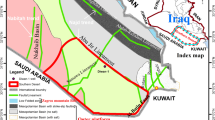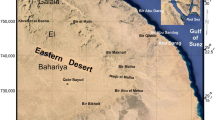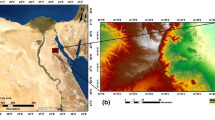Abstract
A well-known and essential task in magnetic data interpretation is the structural mapping of basement terranes. Useful tools for analyzing the deep basement are edge-detection filters that normalize the first-/second-order gradients of the magnetic field in three spatial directions. Different edge-detection filters can reveal different structures; for example, filters that normally involve higher-order gradients may detect small-scale magnetic sources. This study aims to define magnetic bodies and interpret intra-basement structures from aeromagnetic data. For this purpose, we utilize three commonly used edge-detection filters that show edges as peaks, which can sometimes be quite broad. In addition, we suggest a new high-resolution filter that shows edges as a sharp crossover. The filters have been tested on the Bishop magnetic model and real airborne magnetic data from the Iraq Southern Desert (SD). Comparing the products of the proposed crossover filter with the three common filters shows similar high-resolution products, but the new filter can often highlight both shallow and deep subtle basement fabric. Our study of the SD magnetic dataset defined older reactivated regions, structural elements, and the trends of intra-basement fractures associated with more recent seismic events.














Similar content being viewed by others
References
Al-Banna ASh, Ali KK (2018) The Transition tectonic zone between the two parts of the platform in iraq: a review study. Iraqi J Sci 59:1086–1092
Aqrawi AAM, Goff JC, Horbury AD, Sadooni FN (2010) The petroleum geology of Iraq. Scientific Press, UK, p 424p
Baranov V (1957) A new method for interpretation of aeromagnetic maps: Pseudo-gravimetric anomalies. Geophysics 22:359–382
Baranov V, Naudy H (1964) Numerical calculation of the formula of reduction to the magnetic pole. Geophysics 29:67–79
Buday T, Jassim SZ (1984) Geological map of Iraq 1:1000,000 Scale Series, sheet No. 2, Tectonic Map of Iraq. Publication of GEOSURV, Baghdad, Iraq
Cooper GRJ, Cowan DR (2006) Enhancing potential field data using filters based on the local phase. Comput Geosci 32:1585–1591
Cooper GRJ, Cowan DR (2008) Edge enhancement of potential-field data using normalized statistics. Geophysics 73(3):H1–H4. https://doi.org/10.1190/1.2837309
Cordell L (1979) Gravimetric expression of graben faulting in Santa Fecountry and the Espanola Basin. New Mexico Geol. Soc. Guidebook, 30th Field Conference, New Mexico, 59–64
Elkins TA (1951) The second derivative method of gravity interpretation. Geophysics 16(1):29–50
Fairhead JD and Williams S (2006) Evaluating normalized magnetic derivatives for structural mapping. 76th annual international meeting, SEG, expanded abstracts, P. 845–848. https://doi.org/10.1190/1.2370388
Ferreira FJF, de Souza J, de Bongiolo ABS, de Castro LG (2013) Enhancement of the total horizontal gradient of magnetic anomalies using the tilt angle. Geophysics 78(3):J33–J41
Fox JE and TS Ahlbrandt (2002) Petroleum geology and total petroleum systems of the Widyan Basin and Interior Platform of Saudi Arabia and Iraq. United States Geological Survey Bulletin 2202E, 26
Hidalgo-Gato MC, Barbosa VCF (2017) The monogenic signal of potential-field data: a python implementation. Geophysics 82(3):F9–F14. https://doi.org/10.1190/geo2016-0099.1
Jassim SZ “Late Precambrian development of Arabian Plate.” Geology of Iraq. Edited by SZ Jassim and JC Goff 2006, Dolin, Prague, pp. 27–31
Lei K, Fairhead JD, Kerrane T and Al-Bassam KS (2011) Reprocessing of Iraq magnetic and gravity data. International Workshop on Gravity, Electrical and Magnetic Methods and Their Applications, Beijing, China. https://doi.org/10.1190/1.3659043
Miller HG, Singh V (1994) Potential field tilt a new concept for location of potential field sources. J Appl Geophys 32:213–217
Mohammed SAG (2006) Megaseismic section across the northeastern slope of the Arabian Plate. Iraq Geoarabia 11(4):77–90
Nabighian MN (1972) The analytic signal of two-dimensional magnetic bodies with polygonal cross-section: its properties and use for automated anomaly interpretation. Geophysics 37:507–517
Nabighian MN (1974) Additional comments on the analytic signal of two-dimensional magnetic bodies with polygonal cross-section. Geophysics 39:85–92
Pham LT, Vu TV, Le-Thi S, Trinh PT (2020) Enhancement of potential field source boundaries using an improved logistic filter. Pure Appl. Geophys. 177:5237–5249. https://doi.org/10.1007/s00024-020-02542-9
Smith RS, Roots EA, Vavavur R (2022) Transformation of magnetic data to the pole and vertical dip and a related apparent susceptibility transform: Exact and approximate approaches. Geophysics 87(2):G1–G14. https://doi.org/10.1190/geo2020-0827.1
Thurston JB, Smith RS (1997) Automatic conversion of magnetic data to depth, dip, and susceptibility contrast using the SPITM method. Geophysics 62:807–813
Verduzco B, Fairhead JD, Green CM, MacKenzie C (2004) New insights to magnetic derivatives for structural mapping. Geophys Lead Edge 23:116–119
Acknowledgements
We thank the Iraq Geological Survey (GEOSURV) for providing the magnetic data. We acknowledge Ed. K. Biegert (researcher, USA) for reading the manuscript and his comments/suggestions that improved the work. We also thank Dr. Rao Yalamanchili (RGS, USA) and the two anonymous reviewers for their valuable comments and suggestions on the manuscript.
Funding
This research did not receive any specific grant from funding agencies in the public, commercial, or not-for-profit sectors.
Author information
Authors and Affiliations
Corresponding author
Ethics declarations
Conflict of interest
The author has declared that there are no competing interests.
Additional information
Edited by Prof. Bogdan Mihai Niculescu (ASSOCIATE EDITOR) / Prof. Gabriela Fernandez Viejo (CO-EDITOR-IN-CHIEF).
Rights and permissions
Springer Nature or its licensor (e.g. a society or other partner) holds exclusive rights to this article under a publishing agreement with the author(s) or other rightsholder(s); author self-archiving of the accepted manuscript version of this article is solely governed by the terms of such publishing agreement and applicable law.
About this article
Cite this article
Al-Bahadily, H.A., Al-Rahim, A.M. & Smith, R.S. Determination of reactivated regions and faults in the Iraq Southern Desert with the new edge technique, Inverse Tilt Angle of Second-gradients (ITAS). Acta Geophys. 72, 1675–1692 (2024). https://doi.org/10.1007/s11600-023-01176-4
Received:
Accepted:
Published:
Issue Date:
DOI: https://doi.org/10.1007/s11600-023-01176-4




